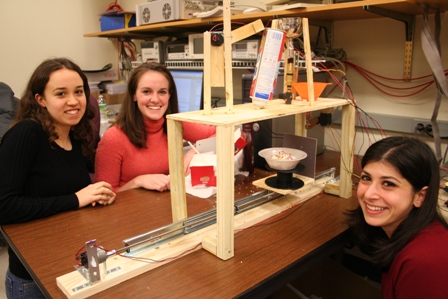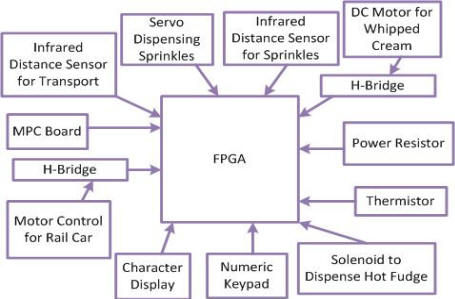
Team Members (left to right): Kelsey MacLennan, Katie Maertens, Nicole Kizy
Introduction
We have designed and built an automatic ice cream topping dispenser. The user may choose from three different toppings: sprinkles, hot fudge, and whipped cream. The user is prompted to begin their order and enter toppings from the character display and corresponding keypad. After the user has chosen their desired toppings, the system transports the bowl of ice cream to the corresponding stations where each topping is dispensed. When the order is complete the ice cream sundae is delivered to the user at the end of the transport.
Task Distribution
Nicole: Character Display, DC Motor with H-Bridge, Power Resistor with Relay, Construction
Kelsey: Keypad, Distance Sensors, Solenoid, Servo, DC Motor, Thermistor, Construction
Katie: Solenoid, Distance Sensors, Thermistor, Power Resistor, Construction
High Level Description
Our project was an automated ice cream topping dispenser. It had a horizontal transport rail system that delivered the bowl of ice cream to the topping stations. The user determined which toppings they wanted by using a key pad and reading the options off of the character display. Based on what the user chose, the bowl moved to the corresponding topping stations in the order they were entered. The bowl stopped based on a distance sensor mounted on the end of the horizontal rail transport.
The topping choices were sprinkles, warm syrup, and whipped cream. The syrup was in a metal funnel and was dispensed using a solenoid and copper reducers. We attempted to heat the syrup with a power resistor however the heat did not travel as we expected. We then decided that it was best to use the temperature sensor to measure the area near the heater and display it on the character display, rather than reading the temperature of the syrup which we found to be fairly constant. The sprinkles were placed in a plastic funnel and dispensed using a servo. An infrared distance sensor was used to detect the level of the sprinkles, notifying the user to refill them when they were running low. The tip of the whipped cream can was fixed in a hole in the platform above the rail. We used a DC motor with an H-bridge to press on the top of the can to dispense the whipped cream.
Component Diagram

Results of the Design
For the most part our design
worked as we had planned, and we were extremely satisfied with our
results. The only components
that we had some difficulty with were the power resistor to heat the
syrup, and the whipped cream dispenser.
We needed to heat the syrup with the power resistor but we were
unsure of the best way to do this.
We thought it would be easy to thoroughly heat the syrup, but
this was not the case. We
ended up taping the power resistor to the side of the metal funnel with
metal tape. This essentially
worked but only heated the area around the funnel where it was touching.
We had hoped that the heat current would travel better through
the metal however it did not.
As a result, it was more difficult to successfully heat the
syrup.
Also, an issue we faced with the
whipped cream that we did not account for was how much whipped cream was
in the can. With a full can,
the time that it dispensed did not need to be as long.
As the can emptied, to receive a suitable amount of whipped cream
the motor dispensing it needed to be left on for a longer amount of
time. However, for the
purpose of our project this was not a huge issue, and our whipped cream
still dispensed a reasonable amount.
With our design we did not have to compromise any functionality, change
processing or control implementations.
We had no unresolved problems, and were very happy to
successfully complete our demo!
Conclusion
Overall, we felt that our project went quite well.
We had many components that we needed to investigate,
characterize and integrate into our program, but we allowed enough time
to get each one working. The
one thing we wish we could have turned out better is our method of
heating the syrup. We ended
up attaching a power resistor to a metal funnel, but it was difficult to
make a good contact surface with funnel since it was spherical.
By using several more power resistors, or by figuring out a way
to submerge the heater in the syrup without getting lead into it (i.e.
plastic coating), we may have been able to get the syrup noticeably hot.
There were several food and fire safety concerns which prevented
us from using a heat lamp, or immersing a heat source directly in the
syrup. We were still very
happy with how the project turned out – it was so much fun (and work and
time and frustration) to watch this far-out idea turn into an awesome
invention!